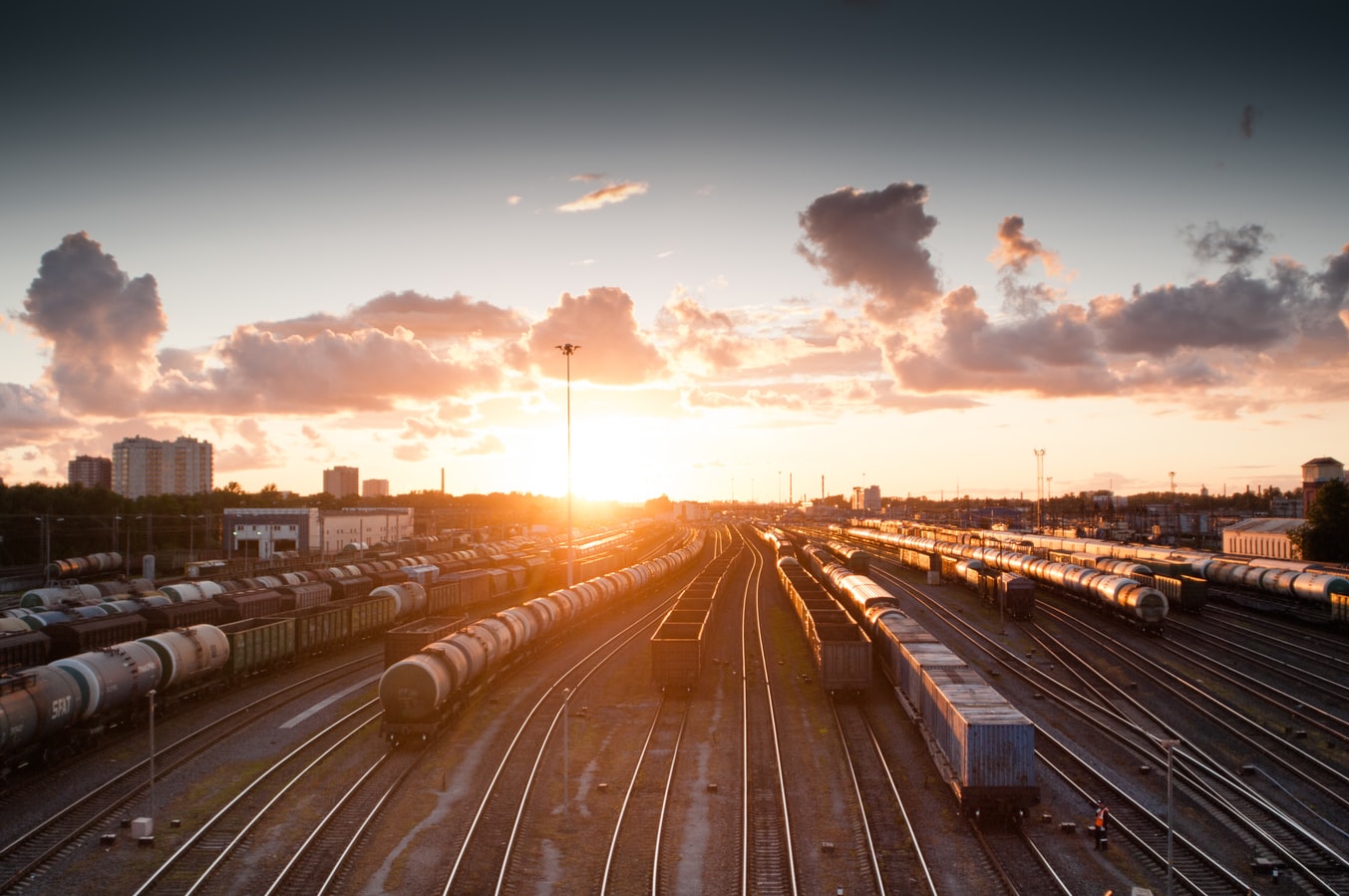The Data
Let’s start with the data. For this blog, I’m using 91 days of train and traffic data collected by TRAINFO at the Waverley St rail crossing in Winnipeg, Manitoba. We recorded the start and end time of every rail crossing blockage using our trackside, train detection sensors and measured the unique travel time across the tracks for individual vehicles using roadside Bluetooth sensors. Essentially, we had a population of data for three months. One other important note – we have similar data for several other crossings in Canada and the US which match the patterns described in this blog.
Total Rail Crossing Blockages
During this 91-day period, we recorded about 3,100 rail crossing blockage events. The figure below shows the distribution of these events based on the blockage duration. The most common blockage duration was around 6 minutes.
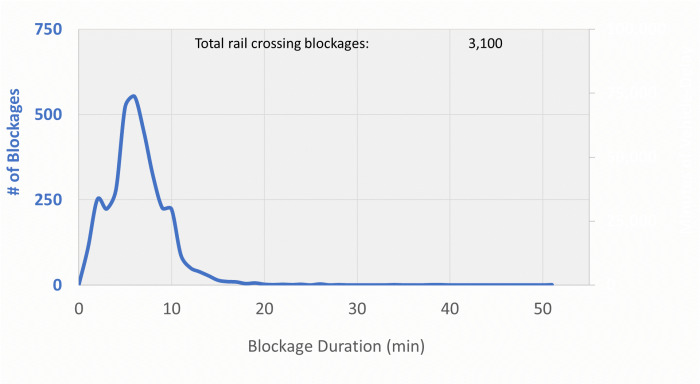
Traffic Delays Caused by Rail Crossing Blockages
During this 91-day period, the 3,100 rail crossing blockages (shown as a blue line) caused over 266,000 minutes of vehicle-delay (shown as an orange line), as illustrated in the figure below. You can start to see that longer blockage durations are causing disproportionately more traffic delay. If blockage duration were proportional to traffic delay, you would expect to see the orange and blue lines to overlap. If shorter blockage durations caused more traffic delay than longer blockage durations, you would see the orange line skew to the left of the blue line, not to the right as currently shown.
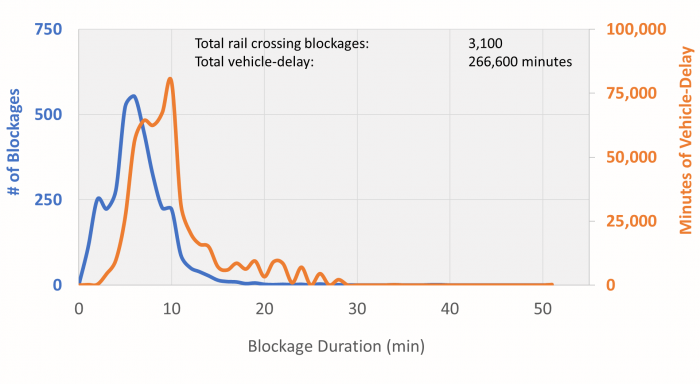
Interpreting the Data
The figure below helps explain how to interpret this graph. For example, during this 91-day period, there were 240 rail crossing blockages that lasted for 10 minutes; i.e., the flashing lights, bells, and gates were activated for 10 minutes. The cumulative traffic delay of all 10-minute blockages was about 80,000 minutes. Therefore, 7.7% of rail crossing blockages (240 of 3,100) caused 30% of traffic delays (80,000 of 266,600).
Before moving on, think about this for a second. One train out of 10 may be causing 1/3 of traffic delays at a rail crossing. Knowing when this one train is coming and advising drivers how to avoid it could help reduce traffic delays and vehicle emissions at rail crossings by more than 25%.
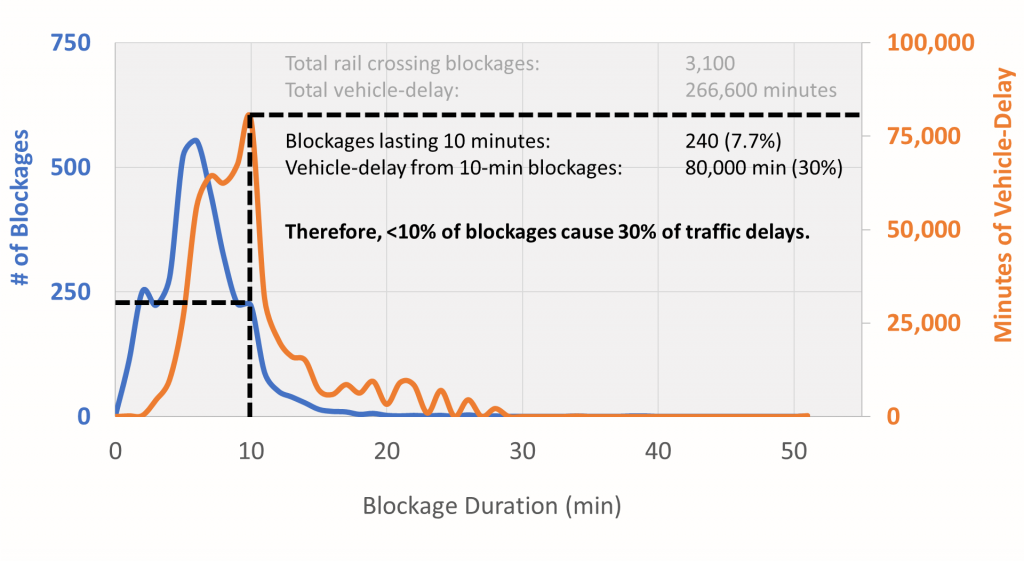
The figure below offers another way to interpret the data. The black shaded area represents vehicle-delay caused by a range of rail crossing blockage durations. In this graph, the two shaded parts have the same area and therefore represent the same amount of vehicle-delay. What this graph shows is that rail crossing blockages that are 5-minutes or shorter (1,385 in total) cause the same amount of traffic delay as rail crossing blockages that are 19 minutes or longer (23 in total).
In other words, preventing traffic delays caused by 23 long trains could have the same affect as preventing traffic delays caused by 1,385 short trains. This underscores the importance of predicting long trains and helping drivers re-route around them.
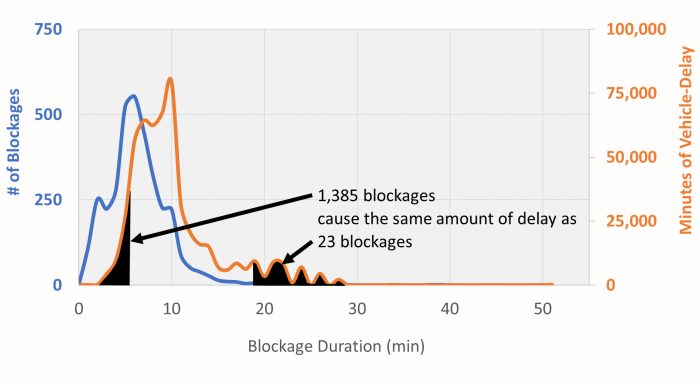
Observations
As mentioned, the results of this analysis are similar for many rail crossings. A small number of long rail crossing blockages produce the same amount of traffic delay as a large number of short blockages. This is not necessarily obvious, but also not that surprising, either. However, without quantifying this effect, this level of knowledge is not very practical.
For instance, re-routing around blocked crossings does not always save time. Sometimes it is still faster to wait for the train to clear than to take a circuitous detour. But at what point is it better to re-route? The answer depends on specific situations and individual trip destinations. We’ve generally found that re-routing begins to make sense when rail crossing blockages are about 10 minutes or longer. (Although this is not usually the case for emergency vehicles).
The key is being able to determine the re-route threshold and predicting when the blockage duration will exceed this threshold. This is not a simple task. Many factors are at play: train speed, acceleration and deceleration, travel direction, presence of multiple trains, train length, movement type (through vs switching), temperature, and many others. Further, the impact of a 10-minute blockage at 9:00 am on a Tuesday can be different than at 4:00 pm on a Friday, so the combined affects of train characteristics and traffic characteristics must be considered and predicted for every rail crossing blockage event. Fortunately, TRAINFO’s patented, machine-learning process is up to the challenge.
Surprise Ending
Now for the surprise ending: simply telling drivers that a crossing is blocked is not helpful and may actually be detrimental. In fact, there is a high risk that only notifying drivers that a crossing is blocked (without predicting the blockage and without predicting traffic delays) will lead to poor travel decisions and increase traffic delays on the road network. Using the 91-day dataset in this blog, about 1 out of 10 blockages were longer than 10 minutes and warranted re-routing. The other 9 times it would be better to wait at the crossing. Therefore, there’s a risk that 90% of the time a basic notification would result in increased traffic delays compared to providing no information at all.
Here’s a summary and simple chart to illustrate the driver notification options and their impact on traffic delay.
- Option 1 – No Information: drivers do not receive advanced information about a blocked crossing. A driver may observe flashing lights, bells, and gates as they approach the crossing, but do not have enough warning to re-route. Traffic delays at rail crossings are neither increased nor decreased.
- Option 2 – Basic Information: drivers receive an advanced notification that a crossing is blocked. This notification does not predict when the train will arrive or clear the crossing, nor does it predict the expected traffic delays. Traffic delays are likely increased due to drivers re-routing, even if it’s faster to wait for the train to clear the crossing.
- Option 3 – Predictive Information: drivers receive an advanced notification about expected traffic delays at a rail crossing before the train arrives and a recommended re-route option if detouring will save time. Traffic delays are reduced at rail crossings.
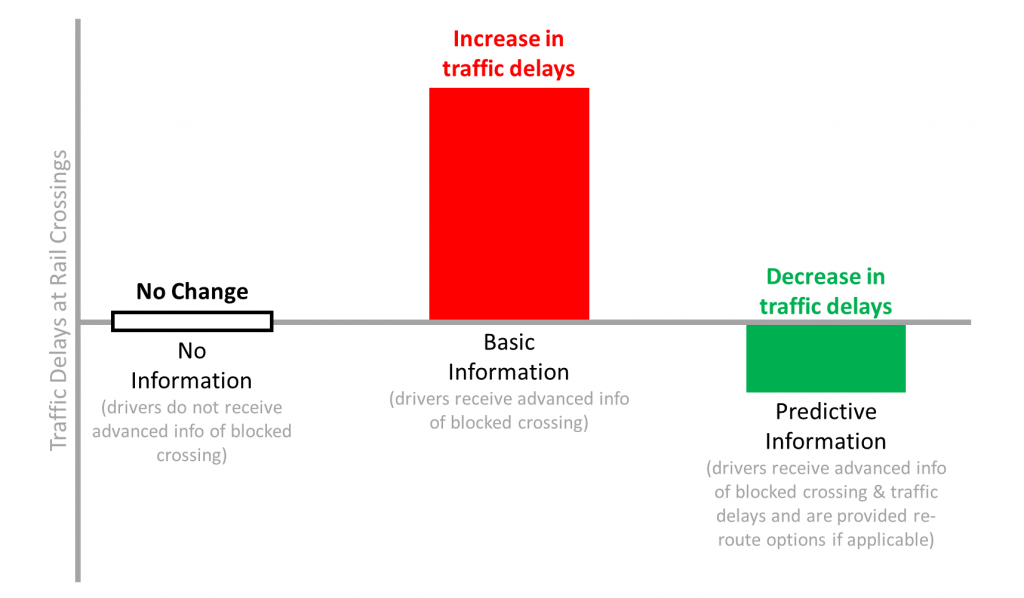
By now I hope it’s clear. Not all trains impact traffic the same way and only a certain proportion of trains produce traffic delays that are long enough to justify re-routing around them. If you want to decrease traffic delays at rail crossings, only a system that can predict traffic delays at rail crossings will work.

